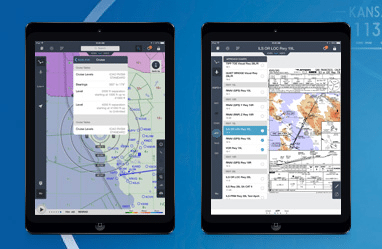
Jeppesen Mobile FliteDeck. Photo, courtesy of Jeppesen.
After seven years, the U.S. Air Force Air Mobility Command (AMC) has proof of the value of portable electronic EFBs in transport-category military aircraft.
What started off in 2010 as an EFB initiative to improve the effectiveness and efficiency of AMC aircrews on C5 Galaxy mega-transports is now a money-saving tool on numerous other aircraft, including the C-17, C-130J, KC-10 and KC-135s.
Many Air Force transport aircrews have transitioned to EFB-enabled tablets. Each crewmember on these aircraft is issued an EFB-enabled tablet.
Getting rid of paper in the cockpit started the EFB program. “Slowly, the crews realized the potential out there for EFBs,” said Master Sgt. Joseph Pinkerton, AMC A3 Standard Evaluation C-5M Examiner Loadmaster. Pinkerton is with AMC at Scott Air Force Base, Illinois, located east of St. Louis, Missouri.
From fiscal year 2012 to 2017, the Air Force saved more than $3.7 million in fuel costs by converting to EFB digital navigation charts and plates in various aircraft, said Pinkerton. Removing 120 pounds of paper from every sortie saves roughly $780,000 per year in fuel costs of AMC transports.
Using EFBs increases safety and enhances the crews’ access to technical orders, as well. Crews also can use the portable devices off duty to study their publications and remain proficient.
AMC scrapped obsolete paper checklists and moved to a digital checklist on its various air medical aircraft. “For [air medical] aircrews to jump from aircraft to aircraft and have everything on an EFB lessens the crew burden to carry equipment,” he added.
EFBs enhance safety by allowing aircrews to calculate aircraft performance for safer departures and arrivals and calculate aircraft weight and balance for loading-planning purposes accurately.
Maintaining security of these systems downloaded to tablets is of utmost importance to the AMC, said Pinkerton. “In our line of work, cybersecurity takes precedence over everything,” he added. “We don’t want to detract from the efficiency of using EFBs, but security is important.”
A primary concern is to protect the data exchanged between the flight deck, portable device and the ground from hackers and data thieves.
Avionics suppliers are partnering with the FAA to create a methodology to evaluate aircraft systems and potential threats. Some regulatory bodies are open to sharing data from aircraft to a mobile device and vice versa. Others are cautious.
EFB hardware and software systems developers are working with the Aerospace Industries Association (AIA) to promote industry awareness of cybersecurity and to develop better policy. These companies worked with AEEC’s ARINC’s 848 Working Group on a new standard for secure IP broadband communications over public networks. Its next meeting, the EFB Users Forum, is scheduled May 15-17 in Miami, Florida.
AMC recently signed a contract with Blackberry to take over the mobile device management of EFBs. In time, AMC will be in a full mobile content management mode, where the device will be 100% managed by Blackberry and content will be transferred to the portable tablet over a secure network.
AMC is engaged with the Air Force’s Air Combat Command and Special Operations Command, which are “mimicking the exact [EFB] program that AMC is using,” said Pinkerton. “AMC is the lead unit because it is the largest in terms of transport aircraft.”